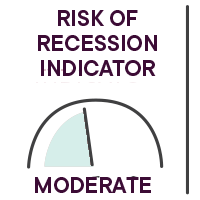What moved the markets in April
- A difficult month for both equities and bonds.
- New surge in inflation and further policy rate hikes by central banks.
- Management of the new COVID-19 wave in China and slowdown of its economy.
- Invasion of Ukraine and impact of the war on commodity prices.

|
OVERVIEW OF GLOBAL EQUITY MARKETSS |
||||
|
Country |
Index |
Return |
Change |
Year-to-date return |
|
Canada |
S&P/TSX |
-4.96% |
|
-1.33% |
|
United States |
S&P 500 |
-6.60% |
|
-11.89% |
|
|
Nasdaq |
-11.23% |
|
-20.07% |
|
International stock markets |
EAFE |
-4.30% |
|
-10.96% |
|
Emerging markets |
|
-3.37% |
|
-11.11% |
|
China |
MSCI China |
-1.86% |
|
-16.73% |
* All percentages are in Canadian dollars. Source: Morningstar Direct.
Key events

Policy rate hikes continue
After telling the markets that they would raise rates this year, central banks followed through with new rate hikes:
- On April 13, the Bank of Canada raised its policy rate by 0.5%.
- On May 4, the Fed raised its key rate by 0.5%.
Comments from various members of the Fed over the past month suggest that rate hikes will be bigger (up to 0.50% at some meetings) and quicker. The objective expressed by the Bank of Canada and by the Fed is to reduce inflation as quickly as possible.
These rate hikes are particularly difficult for the stocks of technology companies, especially those that are not profitable.
The Fed wants to reduce its balance sheet
The reduction of the Fed’s balance sheet will begin in June at a slower-than-expected pace, then get up to speed three months later. This reduction program means that the proceeds from certain maturing bonds as well as the coupon payments on bonds held by the central bank will no longer be reinvested. This measure should have the same effect as an increase in interest rates.
Difficult balance
The markets fear that central banks, in an effort to reduce inflation, will raise rates too aggressively and that reducing their balance sheets will cause a global recession. If central banks want to preserve economic growth without creating a recession (instead of just a slowdown), they won’t be able to raise rates as quickly as expected. They must maintain growth as much as possible, while limiting inflation. The risk of stagflation remains very real if the economic slowdown is too pronounced, without a simultaneous fall in inflation.
Job creation fluctuating
In the United States, job creation was stronger than forecast, with 428,000 new jobs versus expectations of 380,000. The labour force participation rate declined, which is a negative factor since people of working age are leaving the labour market. The unemployment rate remained stable at 3.6% and the job market is still healthy.
In Canada, 15,300 jobs were created in April, falling short of the 40,000 jobs initially forecast. The unemployment rate fell to 5.2%, still below the last record low of 5.5% recorded in 1976 and even lower than last month (5.3%). The labour force participation rate fell to 65.3% from 65.4% last month. Labour shortage issues persist. This new data should have no effect on the actions taken by the Bank of Canada, since the labour market recovery has been achieved and the central bank’s measures are focused on inflation.
Source: Bloomberg.
Results – Canadian bonds
The FTSE Canada Universe Bond Index posted a negative return of 3.14% in April. (Source : Morningstar Direct)
Performance of our funds
View the returns

Our strategic monitoring
Our internal and external managers have taken several steps since the beginning of the year to reduce portfolio risk.
- For clients, we maintained a high weighting in Canadian equities, which react positively in an inflationary environment where demand for metals and energy is greater.
- Our managers invest in quality, less volatile stocks. They also favour companies that have the ability to pass on their cost increases in their products and services, which limits the effect of inflation on their margins.
- Our Canadian managers also increased the weight of Nutrien, which is one of the largest producers of potash and other fertilizers, whose prices are rising sharply. The increased demand for these products is due to sanctions imposed on large Russian and Belarusian producers, who have restricted the sale of their products internationally.
- As for fixed income, certain strategies limit the negative impact of rate hikes on the portfolios.
Main risks
- The possibility of an episode of stagflation, i.e. anemic economic growth and high inflation, persists. This situation is negative for the stock markets.
- An overly restrictive monetary policy could cause a major economic slowdown or even a recession.
- A prolonged lockdown in China due to the zero COVID-19 strategy would keep unsustainable pressure on supply chains.
- A major recession could occur in Europe if Germany decides to cut off all Russian gas imports.
Fundamental indicators
Some economic indicators that we continued to follow in April.
Benchmark rates in Canada, Europe and the United States ![]()
Rate hikes continue and central banks are acting aggressively to reduce inflationary pressures.
Global Purchasing Managers’ Index ![]()
The index remains above 50, which indicates an economic expansion. China’s number is below 50 and thus in contraction territory. This negative trend became more pronounced in April.
Inflation rate ![]()
The inflation rate far exceeds central banks’ targets, which is forcing them to raise their policy rates. The crisis in Ukraine is increasing the costs of both energy and food, two components on which rate hikes have a limited effect. By disrupting supply chains, China’s zero COVID-19 strategy risks increasing inflationary pressures.
 |
 |
| François Landry, CFA Vice-President and Chief Investment Officer |
Yann Furic, B.B.A., M.Sc., CFA Senior Manager, Asset Allocation and Alternative Strategies |
Data source: Bloomberg
The opinions expressed here and on the next page do not necessarily represent the views of Professionals’ Financial. The information contained herein has been obtained from sources deemed reliable, but we do not guarantee the accuracy of this information, and it may be incomplete. The opinions expressed are based upon our analysis and interpretation of this information and are not to be construed as a recommendation. Please consult your Wealth Management Advisor.




















